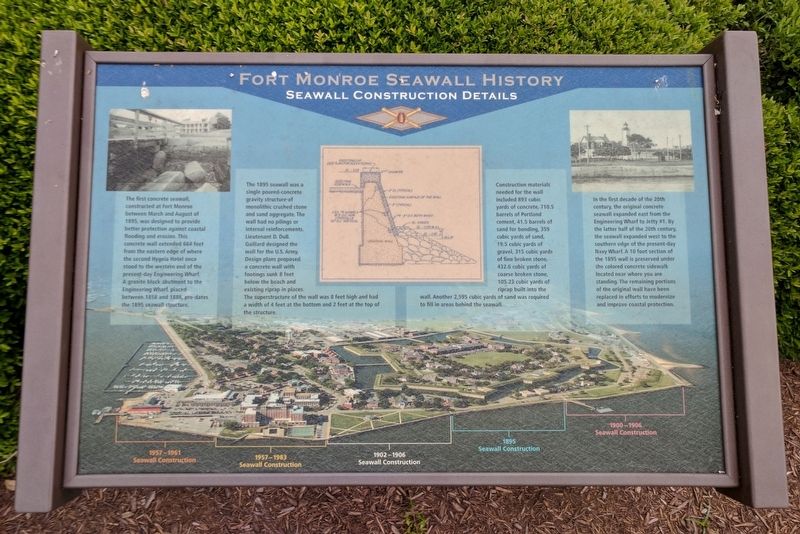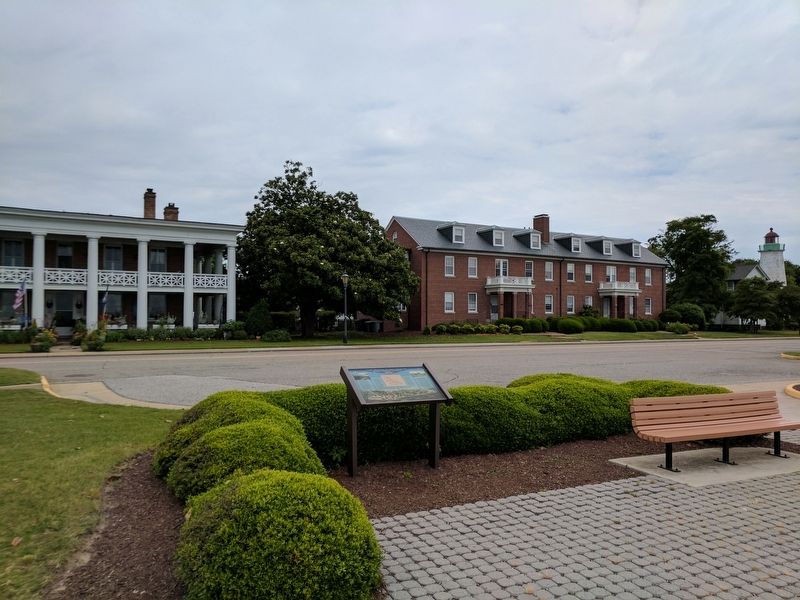Fort Monroe in Hampton, Virginia — The American South (Mid-Atlantic)
Fort Monroe Seawall History
Seawall Construction Details
The first concrete seawall, constructed at Fort Monroe between March and August of 1895, was designed to provide better protection against coastal flooding and erosion. This concrete wall extended 664 feet from the eastern edge of where the second Hygeia Hotel once stood to the western end of the present-day Engineering Wharf. A granite block abutment to the Engineering Wharf, placed between 1858 and 1888, pre-dates the 1895 seawall structure.
The 1895 seawall was a single poured-concrete gravity structure of monolithic crushed stone and sand aggregate. The wall had no pilings or internal reinforcements. Lieutenant D. DuB. Gaillard designed the wall for the U.S. Army. Design plans proposed a concrete wall with footings sunk 8 feet below the beach and existing riprap in places. The superstructure of the wall was 8 feet high and had a width of 4 feet at the bottom and 2 feet at the top of the structure.
Construction materials needed for the wall included 893 cubic yards of concrete, 710.5 barrels of Portland cement, 41.5 barrels of sand for bonding, 359 cubic yards of sand, 19.5 cubic yards of gravel, 315 cubic yards of fine broken stone, 105.23 cubic yards of riprap built into the wall. Another 2,595 cubic yards of sand was required to fill in areas behind the seawall.
In the first decade of the 20th century, the original concrete seawall expanded east from the Engineering Wharf to Jetty #1. By the latter half of the 20th century, the seawall expanded west to the southern edge of the present-day Navy Wharf. A 10 foot section of the 1895 wall is preserved under the colored concrete sidewalk located near where you are standing. The remaining portions of the original wall have been replaced in efforts to modernize and improve coastal protection.
Topics. This historical marker is listed in these topic lists: Forts and Castles • Man-Made Features. A significant historical year for this entry is 1895.
Location. 37° 0.068′ N, 76° 18.443′ W. Marker is in Hampton, Virginia. It is in Fort Monroe. Marker is on Fenwick Road east of Engineer Lane, on the right when traveling east. Touch for map. Marker is in this post office area: Fort Monroe VA 23651, United States of America. Touch for directions.
Other nearby markers. At least 8 other markers are within walking distance of this marker. Fort Monroe History (here, next to this marker); Engineer Wharf (a few steps from this marker); a different marker also named Fort Monroe Seawall History (a few steps from this marker); First Africans in Virginia (within shouting distance of this marker); Old Point Comfort Light (about 300 feet away, measured in a direct line); Notable Locations in the Hampton Roads (about 400 feet away); Retreat / Courtesies (about 400 feet away); "Ruth Window" (about 400 feet away). Touch for a list and map of all markers in Hampton.
Also see . . .
1. Fort Monroe National Monument. National Park Service (Submitted on May 29, 2017.)
2. Fort Monroe (Stone Fort) National Register of Historic Places Registration Form. (Submitted on August 19, 2019.)
Credits. This page was last revised on February 1, 2023. It was originally submitted on May 29, 2017, by Bernard Fisher of Richmond, Virginia. This page has been viewed 260 times since then and 28 times this year. Photos: 1, 2. submitted on May 29, 2017, by Bernard Fisher of Richmond, Virginia.

